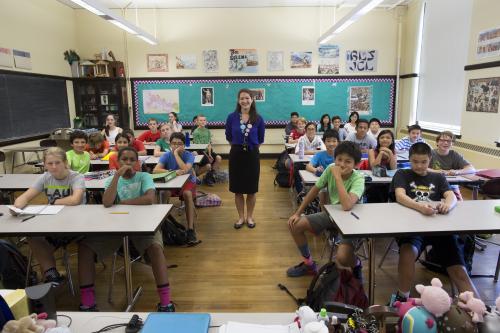This post is part of “Teacher diversity in America,” a series from the Brown Center on Education Policy that examines minority underrepresentation among public educators in the U.S.
Many education policymakers and practitioners across the country recognize the need to recruit and retain more racial and ethnic minorities into the teaching profession. As we’ve previously discussed in our ongoing teacher diversity series, there is credible evidence that minority teachers can boost a range of minority student outcomes, yet minorities are underrepresented among the population of public school teachers.
In light of the scarcity of minority teachers, many states and districts have begun trying ways to somehow bring more minorities into the classroom. To our knowledge, most of these methods have taken the form of targeted outreach, whether to minority communities or teacher preparation programs in universities serving high concentrations of minority students. Though it may be too soon to know whether these different strategies ultimately pan out, we ask if another type of strategy might be effective. That is, could financial incentives help diversify the teacher workforce?
In this installment, we use school- and district-level data from the Schools and Staffing Survey (SASS) to examine this question.[1] We explore whether districts that offer different types of financial incentives to teachers tend to have greater diversity among teachers within their schools. Based on our analysis, we see a strong association between workforce diversity and four incentive policies that may be particularly attractive for minority teachers. Though we cannot say whether these relationships are causal, the results suggest these policies are worth exploring as strategies for diversifying the teacher workforce.
What financial incentives do districts offer?
Before diving into the analysis, let’s take a moment to discuss what types of financial incentives districts offer. The survey asks districts about whether they offer financial incentives either to help recruit new teachers or to target bonus payment to specific teachers. The survey provides eight different financial incentive options.
The first four types of incentives are intended as recruitment tools and are, by nature, short-term rewards. The four incentives are signing bonuses (offered in 3.8 percent of sample districts), student loan forgiveness (2.5 percent), funds to assist with relocation expenses (2.6 percent), and finder’s fees to existing district staff for referring those hired as new teachers (1.7 percent).
The remaining four incentives are intended to reward specific types of teachers or those filling specific needs the district may have, and the reward is generally more permanent. These four incentives are bonuses for obtaining National Board for Professional Teaching Standards (NBPTS) certification (offered in 24.5 percent of districts), demonstrating excellence in teaching (11.2 percent), teaching in schools in “less desirable” locations (5.6 percent of districts) or filling positions in fields or subject areas experiencing shortage (13.4 percent).
For the most part, prior research studies have shown that some of these incentives are successful in either attracting or retaining teachers when they offer at least modest bonuses. However, much of the empirical work has focused on state-level policies, not district-level policies that are captured in the data we’re looking at here; further, these data do not show the value of the incentives, but simply whether they are offered.
Another important detail is that these incentives are offered to district employees without regard to teachers’ race or ethnicity. In fact, our investigation into financial incentives is motivated precisely because we suspect that some types of bonuses may be more attractive to teachers of particular demographics, in spite of being race neutral on its face.
Where are financial incentives offered?
Not all districts offer incentives, and it is instructive to first look for common features among those that offer them. We considered whether district features like total enrollment, the district’s locale, or racial makeup of students made a district more or less likely to offer each type of incentive. A few noteworthy patterns emerged.
We found these incentives are quite common in urban districts, where 61 percent of our sample offers at least one type of incentive. By comparison, between 38-40 percent of districts in other locales offer at least one incentive. Even though urban districts are more likely to offer incentives, they only constitute about one quarter of all districts offering incentives as shown in Figure 1.
Districts also offered different types of incentives based on their location. For example, controlling for student body characteristics, we find that urban districts were much more likely to offer rewards for excellent teaching while rural school districts were the most likely to offer signing bonuses, relocation help and financial incentives for hard-to-staff schools. Suburban districts, on the other hand, are less likely to offer any type of incentive than we had otherwise expected based on their student bodies.
Also, the student bodies in districts that offer some type of financial incentive are different from those that do not, regardless of location. Offering districts tend to have higher levels of poverty and higher proportions of minority students. In addition, offering districts tend to employ significantly higher shares of minority teachers, which is not entirely surprising given the relationship between student and teacher minority representation documented in prior studies.
Which policies are associated with teacher diversity?
We now explore whether some of these policies may be associated with teacher diversity in schools. To do this, we estimate a state fixed effect regression in which we predict minority teacher representation at the school level, accounting for the financial incentives offered and other school traits as explanatory variables.[2] In other words, we’re looking for differences in minority representation beyond what we’d expect based on the district’s students and location alone.
We caution that this analysis cannot identify causal relationships between district policies and teacher diversity (causality could flow in either direction, or from a factor common to both). Rather, this exercise is intended to identify which policies are correlated with workforce diversity, as they may offer a good starting place for further exploration on this issue.

Figure 2 illustrates the result of this analysis—each of the eight incentives are listed along the bottom, and the vertical axis represents the estimated percentage point change in the school’s minority representation corresponding to each incentive. The bars represent the confidence interval around each estimate.
What we find is that offering relocation assistance appears to be the strongest predictor of a more diverse teacher workforce, followed closely by loan forgiveness, bonuses for excellence in teaching, and teaching in less desirable locations. These four types of financial incentives are associated with increases of 2 to 4 percentage points in a school’s minority representation among teachers, which is quite large. For reference, the average school in the sample reports that 16 percent of their teachers are minorities.
Signing bonuses, finder’s fees, being certified by the NBPTS, and teaching in shortage fields do not show a significant association with teacher diversity (as shown by the confidence intervals containing 0).
Why these incentives?
Most of the incentives that show a positive association with minority representation have some underlying rationale suggesting they would be particularly attractive for minority teachers rather than white teachers. For example, minority college graduates are significantly more likely than whites to both take out student loans and carry higher balances. Consequently, loan forgiveness policies may be an important factor in helping attract more minorities to districts that offer them. Relocation bonuses—which cover moving costs when new graduates may be particularly cost constrained—also has a similar underlying rationale that would make more indebted minority graduates attracted to that reward.
A bonus for teaching in “less desirable” locations may be attractive for minority teachers for other reasons. Though we do not know the districts’ criteria for determining whether a location is less desirable, it is not a stretch to speculate that eligible schools likely correspond in some way with student poverty and, more to the point, race. Because minority teachers tend to cluster in schools with higher levels of minority students, regardless of the presence of an incentive, a bonus for being in those schools should promote recruitment and retention among teachers that are already quite diverse.
We were surprised, however, that rewarding excellence in teaching shows a positive association with workforce diversity. Existing research shows that minority teachers perform disproportionally lower on teacher evaluations, though whether these are real differences or from bias in teacher evaluations is unclear. Thus, if anything, we expected to see the opposite of what we found; again, however, the correlation does not imply a causal relationship.
Finally, we estimated these same relationships separately in high-poverty schools eligible for Title I program support, versus those that are not. Our results suggested that the school context was important in at least some of these incentives. In other words, if districts wanted to promote more diversity in particular schools, some financial incentives may be more conducive to doing that than others.
Race-blind incentives and racial differences
Most individuals do not go into teaching for the money, but financial rewards can be powerful motivators that help nudge teachers on the margin. Our analysis here is motivated by a hypothesis that some incentives—even when offered to all teachers in a race-blind fashion—may be effective in promoting racial diversity among the teacher workforce. Based on these results, states and districts that are trying to promote more teacher diversity might consider experimenting with some of these policies along with their outreach efforts.
Footnotes
- Data come from the 2011-12 wave of the Schools and Staffing Survey District and School Questionnaires. This nationally representative survey includes information on pay incentives offered by schools districts to retain, recruit, or reward teachers. We use the school questionnaire to obtain school-level information on student enrollment, student and teacher demographics, and locale. Our sample is comprised by 6,449 schools and 4,020 school districts.
- The other explanatory variables include school enrollment, percentage of minority students and students in poverty in the school, school locale (urban, suburban, town, or rural), and school level (elementary school, secondary school, or combined). Because the data does not include state-level practices on these same incentive areas, we estimate the regression using variation across districts within states only, though we find similar results when we use state random effects.
The Brookings Institution is committed to quality, independence, and impact.
We are supported by a diverse array of funders. In line with our values and policies, each Brookings publication represents the sole views of its author(s).









